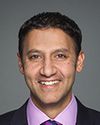Certainly.
To begin, thank you very much for inviting me here today to speak to you about the Maritime Museum of the Atlantic in Halifax, Nova Scotia.
The Maritime Museum of the Atlantic is part of the Nova Scotia Museum system, which is responsible for the provincial collection of over one million artifacts and specimens. The Nova Scotia Museum, consisting of 28 sites, is the most decentralized museum in Canada. It is also one of the oldest museums in the country. It includes more than 210 buildings, four floating vessels, and nine locomotives. It's all across the province.
The Nova Scotia Museum tells the stories of our communities, our natural history, our people's history, our seafaring traditions, our industrial heritage, and our artistic life. The Nova Scotia Museum is governed by the Nova Scotia Museum board of governors through the Nova Scotia Museum Act.
Its sites are either directly or indirectly managed by the Government of Nova Scotia through financial allocations and through the policies, procedure, and accountability of the Department of Communities, Culture and Heritage. The Maritime Museum of the Atlantic is one of the sites that are directly operated by the Province of Nova Scotia.
The Maritime Museum of the Atlantic is located on Halifax's historic waterfront. The museum tells the stories of Nova Scotia's rich maritime history, our seafaring heritage, and our relationship with the sea, from small craft boatbuilding to world war convoys, from the days of sail to the age of steam, from the Titanic to the Halifax Harbour explosion. We are the oldest and largest maritime museum in Canada.
The Maritime Museum of the Atlantic is open year-round and offers both permanent and temporary exhibitions. There are a wide variety of programs in support of the exhibitions, including guided tours for student and adult groups, directed and self-learning assistance, lectures, demonstrations, and educational hands-on opportunities.
We also host many special events throughout the year. As the most visited provincial museum in Nova Scotia, with an annual average visitation of between 130,000 and 150,000 visitors, the maritime museum is considered a provincial icon.
In terms of our facilities, there are two parts to our building proper. We have a circa 1860s heritage building called the Robertson Store. Then we have a new addition that was built in 1980, which is larger. Throughout the two buildings, which are actually combined to be one building, we have nine permanent galleries. We have a temporary exhibition space of approximately 1,500 square feet. We have a very extensive library available by invitation or by request. It's probably one of the largest marine nautical libraries of its kind in North America. We have a small 50-person theatre for different presentations that we host and provide.
We're also, as I said, on the Halifax waterfront, so part of our footprint includes the museum wharves. We have two large jetties and a marginal wharf in between, as well as an anchor yard. We're very fortunate to be located right in the middle of the Halifax waterfront, which is the most visited visitor attraction in Nova Scotia. We do get a lot of people just passing by. From our wharves they can take in CSS Acadia, our 104-year-old exhibit that is out on the water, as well as programming and activities that take place. We're also able to host visiting ships at our jetties.
We also have boat sheds out between the museum proper and the wharves. In the boat sheds we have a number of different hands-on programming and learning opportunities.
We are exploring more and more partnerships through boatbuilding. In the last couple of years we initiated a family boatbuilding program that has really helped us to connect with a variety of community groups, particularly youth. We have activities like that. In the summer one of our boat sheds serves as a gift shop, and we have a year-round gift shop that operates inside the museum proper.
In our services at the maritime museum, as mentioned, we offer a number of different types of tours for different groups. We have large visitations from the cruise ships that come to Halifax, particularly between mid-May and the end of October. Some of them are for visitors from outside the country or the province. We also do tours with schools and we do a lot of outreach in the newcomer and diverse communities in our region. We have a number of tours for English as an additional language that are facilitated by partners coming to our museum. We host a number of different types of demonstrations, ranging from traditional maritime knitting to boatbuilding, as I said, having people learn how to bend frames on a boat or other traditional marine experiences.
We have a number of school programs whereby students come to the museum and participate in activities, and we have developed relationships and partnerships with other community groups, such as the Halifax Amateur Radio Club. Volunteers from their club will come to the museum and work with students on different types of communication, which has been great. As well, we have model-maker volunteers who have played a huge role in preserving our various ship models or making purpose-filled activities. They also engage with the public quite a bit, and we really value that.
We have public talks on a regular basis, and those are free to the public every Tuesday night, generally speaking. In the summer we pause the public talks, or do fewer of them, and shift to concerts in our courtyard space at the museum, which we do in partnership with Waterfront Development.
We are trying more and more to bring in some cultural experiences to the museum. We have a volunteer program, as mentioned. Some volunteers are from particular clubs, such as the model-makers' guild or the Halifax amateur radio operators, but many come as individuals with a particular interest in having experience in a museum.
We do a certain amount of facility rentals, and we bring in travelling exhibits as well. We share exhibits throughout the Nova Scotia Museum system that we create in-house, and currently we have one exhibit at the war museum on the MS St. Louis that will be opening later in March. We host visiting ships, whether they are tall ships or interpretive vessels, and sometimes the navy will bring a vessel to the museum. We have family programming and March break programming and holiday programming, to name a few. There are more.
Our vision at the maritime museum is that Nova Scotians will live in welcoming, healthy, and prosperous communities. They will participate in opportunities for learning and experiencing our diverse maritime culture and heritage. They will feel engaged in current events, feel a strong sense of identity, and will take an active role in advancing the health and prosperity of their communities.
We see our purpose through our work at the maritime museum, which is guided by the Nova Scotia Museum's interpretive master plan and by Nova Scotia's culture action plan. One year ago Nova Scotia launched its first culture action plan. The plan brings to life the mandate of the Department of Communities, Culture and Heritage, which the Nova Scotia Museum is a part of, to contribute to the well-being and prosperity of Nova Scotia's diverse and creative communities through the promotion, development, preservation, and celebration of the province's culture, heritage, identity, and languages.
A formal consultation was held at the Assembly of Nova Scotia Mi'kmaq chiefs.









